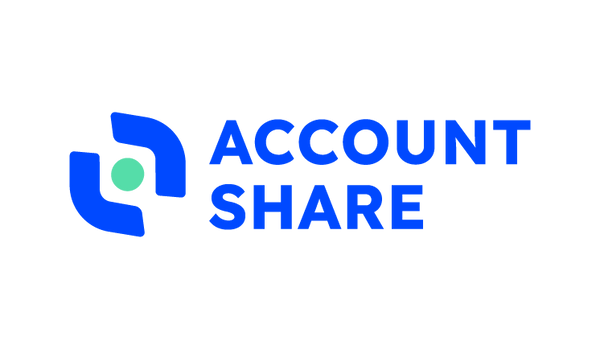
Top Subscription Management Tools for Your Business
Share
Level Up Your Subscription Game
Juggling multiple subscriptions? Stop the chaos and reclaim control of your digital life. This listicle presents ten powerful subscription management tools designed to streamline your accounts, optimize spending, and simplify access for everyone from tech-savvy individuals to growing businesses. Discover which platform best suits your needs—whether you're aiming for cost-effective family sharing or seamless business scaling—by comparing key features and pricing of tools like AccountShare, Chargebee, and Zuora. Stop wasting time and money; take charge of your subscriptions today.
1. AccountShare
AccountShare offers a unique approach to managing and accessing premium digital services, allowing users to leverage the power of group purchasing for significant cost savings. Imagine splitting the cost of a premium streaming service with a few friends or family members, or sharing the expense of essential software tools with your team. AccountShare facilitates this by creating a platform for shared accounts, making premium services more accessible to a wider audience. This is particularly beneficial for tech-savvy individuals, families, small businesses, students, and digital nomads looking to maximize their budgets without sacrificing access to high-quality digital tools and entertainment. Whether you're looking to share streaming platforms like Netflix or Spotify, access AI tools like Jasper or Copy.ai, or utilize professional software suites, AccountShare provides a platform for collaborative consumption.
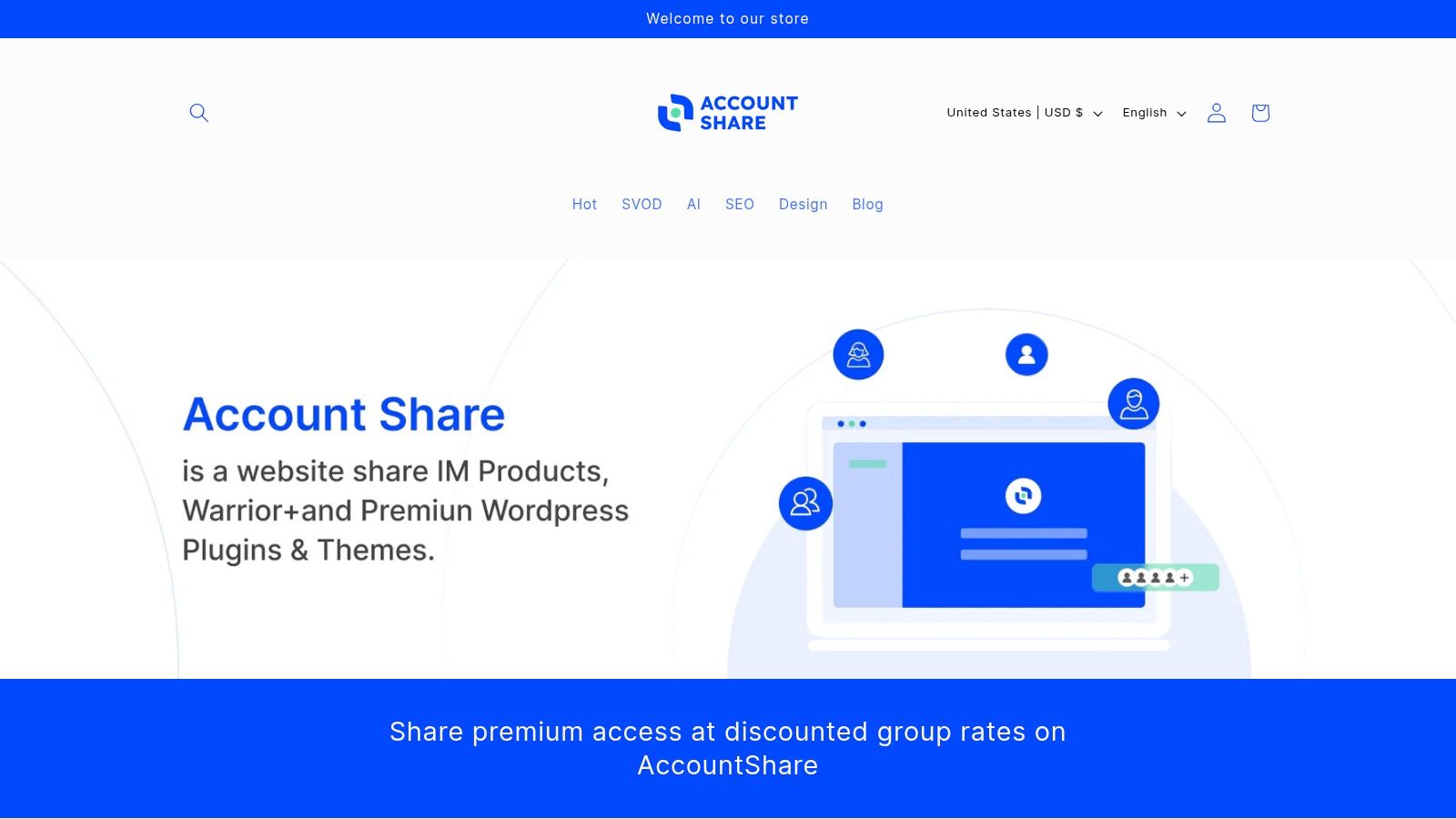
AccountShare distinguishes itself with its focus on high-demand periods, guaranteeing availability and faster response times, which is a common pain point for shared accounts. Furthermore, its robust account management tools provide enhanced security features, including customizable permissions and efficient password sharing. This ensures that control remains in the hands of the primary account holder while allowing for flexible access among group members. For example, a family can share a Disney+ account with children having limited access profiles while parents retain full administrative control. Similarly, a small business can utilize AccountShare to distribute software licenses amongst team members with varying levels of access based on their roles.
While pricing and specific technical requirements aren't available on the website at this time, the platform's core value proposition revolves around cost savings through group purchasing. Compared to traditional subscription management tools that primarily focus on individual account organization and tracking, AccountShare introduces a collaborative element, potentially offering significant financial advantages. The platform aims to streamline the often cumbersome process of setting up and managing shared accounts, potentially eliminating the need for manual password sharing or complex spreadsheets for tracking payments.
Pros:
- Access to a wide range of premium services at discounted group rates.
- Guaranteed availability during peak demand with faster response times.
- Enhanced security features and customizable account sharing options.
- Easy and efficient management of shared subscriptions.
- Positive customer reviews highlighting reliability and cost savings.
Cons:
- Group sharing may occasionally require coordination among users (e.g., scheduling usage of streaming services).
- Limited individual customization options compared to direct subscriptions (e.g., individual profiles on streaming platforms might not be fully supported depending on the service).
AccountShare deserves its place on this list because it offers a novel solution to the rising costs of digital subscriptions. Its emphasis on group purchasing, combined with robust account management features, makes it a valuable tool for anyone looking to save money while maintaining access to essential digital services. For implementation, it is recommended to visit the website and explore the available services and features. As AccountShare evolves, more detailed pricing and technical specifications are expected to become available.
2. Chargebee
Chargebee is a robust subscription management platform geared towards scaling SaaS businesses and other subscription-based models. It goes beyond simple billing automation by providing a comprehensive suite of tools to manage the entire subscription lifecycle, from initial signup and recurring billing to revenue optimization and customer retention. This makes it a powerful option for businesses looking to streamline their operations and maximize recurring revenue. For example, a rapidly growing software company can leverage Chargebee to automate complex billing scenarios, manage multiple pricing tiers and subscriptions, and gain deep insights into their revenue streams. Similarly, a subscription box service can utilize Chargebee's features to manage recurring shipments, handle upgrades and downgrades, and proactively reduce churn through dunning management.

Chargebee's key features include automated billing and invoicing with support for multiple currencies and payment methods, revenue recovery tools (like dunning management and smart retry logic), a comprehensive API and webhook support for custom integrations, subscription analytics and reporting dashboards, and a self-service customer portal. This extensive feature set allows businesses to automate complex billing processes, reduce manual effort, and gain a 360-degree view of their subscription revenue.
While Chargebee offers a free trial, its pricing is generally structured around tiered plans based on revenue and features. Specific pricing details are available upon request from their sales team. Technologically, Chargebee integrates seamlessly with major payment gateways (like Stripe and PayPal), accounting software (like Xero and QuickBooks), and CRM systems (like Salesforce), offering a highly interconnected platform for managing all aspects of your subscription business. This is particularly useful for businesses already utilizing these platforms, ensuring data consistency and streamlining workflows.
Implementation Tips:
- Plan your integration strategy: Map out your existing systems and processes to ensure a smooth integration with Chargebee.
- Utilize the onboarding resources: Chargebee offers dedicated onboarding support to help you get started quickly and effectively.
- Start with core features: Focus on implementing the essential features first before exploring more advanced functionalities.
- Test thoroughly: Before going live, rigorously test all integrations and configurations to ensure everything works as expected.
Comparison with similar tools: Compared to simpler subscription billing tools like Paddle or Recurly, Chargebee provides more advanced features for revenue management and complex billing scenarios. However, this also means a steeper learning curve. While tools like Zoho Subscriptions offer competitive pricing, they might lack the extensive integration ecosystem and robust reporting capabilities of Chargebee.
Pros:
- Highly customizable for various business models.
- Excellent customer support and dedicated onboarding.
- Strong integration ecosystem with 200+ pre-built integrations.
- Robust capabilities for handling complex pricing models.
Cons:
- Can be complex to set up for small businesses with simpler needs.
- Higher pricing compared to some competitors.
- Learning curve can be steep for utilizing all features effectively.
Website: https://www.chargebee.com/
Chargebee earns its place on this list due to its comprehensive feature set and its focus on empowering businesses to scale their subscription revenue. While it may be more suitable for larger or rapidly growing businesses, its power and flexibility make it a top contender for those seeking a robust and scalable subscription management solution. For tech-savvy users looking to manage complex billing structures or digital nomads seeking detailed insights into their subscription analytics, Chargebee provides a valuable toolkit. While it may not be the most budget-friendly option for smaller businesses or students, the free trial and tiered pricing plans offer some flexibility.
3. Zuora
Zuora stands out as a leading enterprise-grade subscription management platform specifically designed to empower businesses to launch, manage, and scale subscription services. Its robust functionalities cater to complex order-to-revenue processes, making it ideal for large-scale operations dealing with intricate subscription models and global reach. If your business involves intricate pricing tiers, multiple product offerings, or international customers, Zuora provides the tools to manage these complexities efficiently. For example, a global SaaS company offering various tiered software packages with different billing cycles across multiple currencies would benefit immensely from Zuora's capabilities. They can automate revenue recognition, manage complex pricing structures, and consolidate financial reporting across all regions.

Zuora offers a comprehensive suite of features encompassing the entire subscription lifecycle. This includes quote-to-cash automation with CPQ (Configure, Price, Quote) functionality, allowing businesses to streamline sales processes and generate accurate quotes quickly. Its robust revenue recognition engine ensures compliance with ASC 606/IFRS 15, crucial for accurate financial reporting. Furthermore, Zuora provides powerful analytics and revenue forecasting tools, giving businesses valuable insights into their subscription performance. The platform also supports multiple currencies and tax jurisdictions, simplifying operations for global businesses. Finally, enterprise-grade security and compliance features ensure data integrity and protect sensitive customer information. You might want to Learn more about Zuora for detailed insights into its capabilities.
While Zuora offers exceptional functionality for large enterprises, it's important to consider its drawbacks. Implementation can be a significant undertaking requiring dedicated resources and substantial investment. The platform's complexity also contributes to a steep learning curve, necessitating thorough training for users. Its pricing reflects its enterprise focus, making it a more expensive option compared to other tools on this list, which might be overkill for smaller businesses or individuals. While Zuora's robust features address complex scenarios effectively, they might be overengineered for simpler subscription models. If your business has straightforward subscription offerings and limited transaction volume, exploring other tools on this list might be a more cost-effective approach.
Pros:
- Comprehensive solution for large enterprise needs
- Robust capabilities for handling complex business models and pricing structures
- Strong financial controls and compliance features
- Excellent scalability for growing businesses
Cons:
- Significant implementation effort and cost
- Steep learning curve requiring dedicated resources
- Higher price point aimed at enterprise customers
- Can be overengineered for smaller businesses
Website: https://www.zuora.com/
While pricing isn't publicly available, it's tailored to each business's specific needs and scale of operations, reflecting its enterprise focus. Technical requirements will vary depending on the specific implementation and integrations required. Zuora offers extensive documentation and support resources to assist with setup and configuration.
4. Recurly
Recurly stands out as a powerful subscription management platform specifically designed to minimize churn and boost subscription revenue. This makes it a valuable tool for businesses heavily reliant on recurring billing, such as SaaS providers, digital content platforms, and subscription box services. Its core strength lies in optimizing payment processing and revenue recovery, leveraging intelligent retry logic and automated dunning to recapture lost revenue. This focus on revenue optimization makes Recurly a particularly compelling option for businesses looking to maximize the lifetime value of their subscribers. Whether you're a growing SaaS startup or an established e-commerce subscription business, Recurly offers the tools to streamline your billing operations and improve your bottom line.
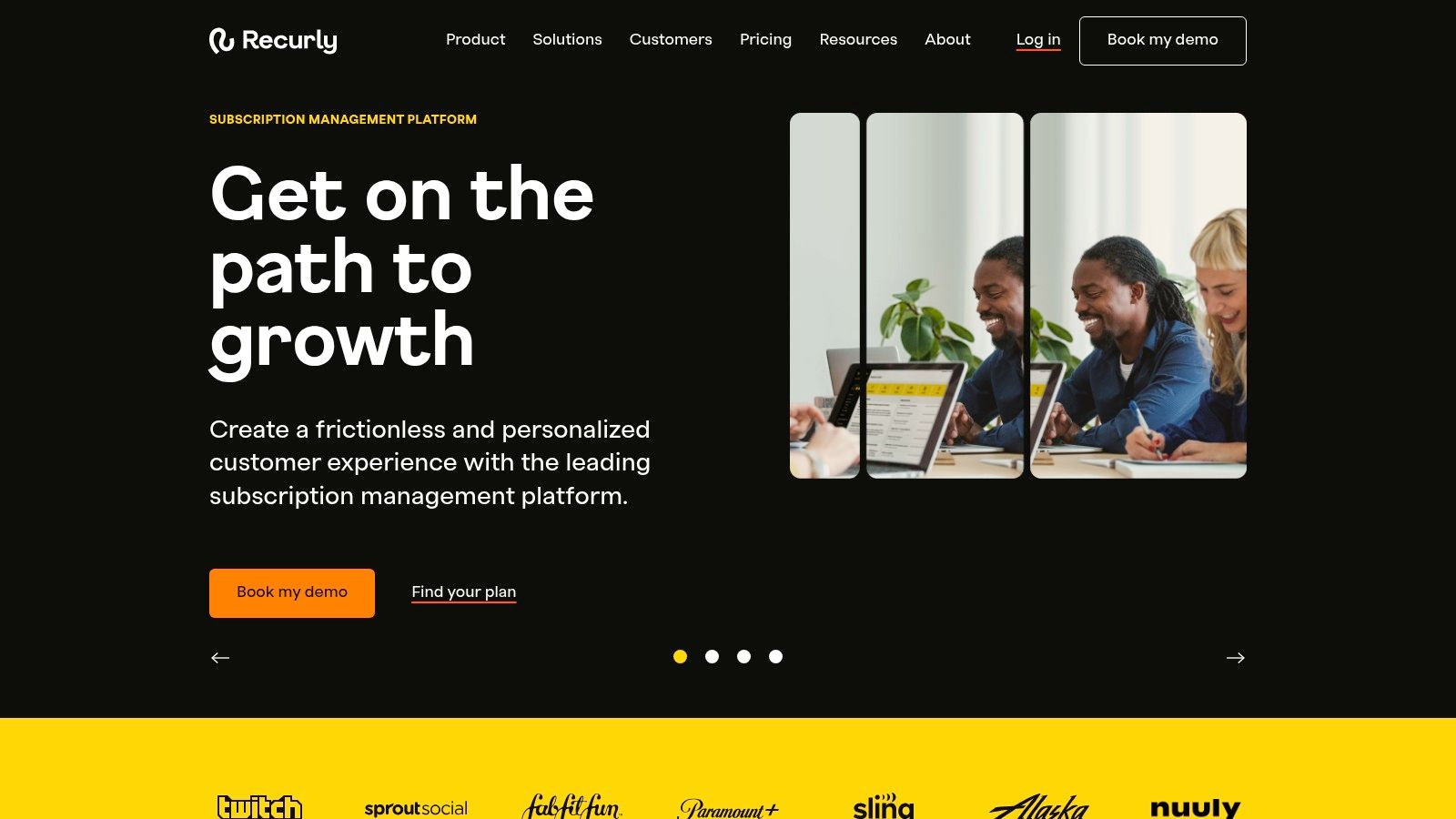
Recurly's robust feature set includes advanced revenue recovery with machine learning-based dunning management. This intelligent system analyzes customer behavior and payment patterns to optimize dunning strategies, significantly increasing the likelihood of successful payment retries. It also provides flexible subscription plan management, allowing businesses to easily create and modify various pricing models, including tiered subscriptions, usage-based billing, and promotional offers. Comprehensive analytics and reporting capabilities give you deep insights into subscription metrics, churn rates, and revenue trends, enabling data-driven decision-making. The platform also offers an account updater service that automatically updates expired credit card information, reducing involuntary churn caused by payment failures. Finally, its PCI DSS Level 1 compliance ensures secure payment processing, safeguarding sensitive customer data.
For tech-savvy individuals, families, small businesses, students, and digital nomads, Recurly's benefits translate to more reliable access to subscribed services and potentially lower costs for businesses, as recovered revenue contributes to overall profitability. Imagine a family sharing a streaming account: Recurly’s account updater feature ensures uninterrupted service even if the primary card expires. For small businesses, the robust analytics tools provide valuable insights into subscription performance, helping optimize pricing and offerings.
Compared to similar tools like Chargebee and Zuora, Recurly shines in its revenue recovery capabilities. While Chargebee offers a broad range of features, Recurly’s machine learning-driven dunning is a significant advantage. Zuora, geared towards larger enterprises, offers extensive customization but can be more complex and expensive to implement.
Implementing Recurly is generally straightforward thanks to its user-friendly interface. While detailed pricing isn't publicly available, it's typically based on transaction volume and specific feature usage, meaning costs can increase as your business scales. Businesses should factor this into their long-term budget planning. It's advisable to contact Recurly directly for a tailored quote based on your specific needs. Technical requirements are minimal as Recurly is a cloud-based platform, requiring only a web browser for access.
Pros:
- Industry-leading revenue recovery capabilities
- User-friendly interface requiring minimal technical setup
- Strong payment gateway integrations
- Excellent churn prevention tools
Cons:
- Limited customization compared to some enterprise solutions (like Zuora)
- Fewer built-in integrations than some competitors (like Chargebee)
- Can become costly as subscription volume grows
Website: https://recurly.com/
Recurly earns its place on this list because of its laser focus on revenue optimization and its user-friendly approach to subscription management. While it may not offer the same level of customization as some enterprise-grade solutions, its powerful revenue recovery features and ease of use make it an ideal choice for businesses looking to maximize their recurring revenue streams.
5. ReCharge
ReCharge stands out as a powerful subscription management platform specifically designed for e-commerce businesses dealing with physical products. If your business model revolves around recurring deliveries of tangible goods, ReCharge offers a streamlined solution to manage the complexities of subscriptions, freeing you to focus on growth. It seamlessly integrates with popular e-commerce platforms like Shopify and BigCommerce, making it incredibly easy to implement and manage recurring billing, order fulfillment, and customer subscriptions. For businesses already invested in these platforms, ReCharge offers a smooth transition into the subscription model.

ReCharge's strength lies in its purpose-built features for physical product subscriptions. Think subscription boxes, replenishment services, or regular deliveries of consumables. It offers flexible subscription options, allowing customers to customize their delivery frequency, dates, and even swap products. The robust customer portal empowers subscribers to manage their subscriptions independently, modifying orders, updating payment information, and skipping deliveries without needing to contact customer support. This self-service functionality not only improves customer satisfaction but also reduces the administrative burden on your team. Furthermore, ReCharge provides inventory forecasting tools specifically for subscription products, helping you anticipate demand and optimize your stock levels to avoid costly overstocking or frustrating stockouts. This feature is crucial for maintaining a smooth and efficient subscription service.
For e-commerce businesses looking to implement a subscription model, the ease of setup with ReCharge is a major advantage. Its deep integrations minimize technical hurdles, allowing for a quicker launch and faster time to revenue. While Learn more about ReCharge provides more details, it's worth noting that the platform offers various pricing tiers based on transaction volume, making it scalable for businesses of different sizes. While specific pricing isn't publicly listed, it generally follows a percentage-of-revenue model plus transaction fees. You'll need to contact ReCharge directly for a tailored quote. Technically, the primary requirement is a compatible e-commerce platform like Shopify or BigCommerce. Implementation typically involves installing the ReCharge app and configuring your subscription offerings.
While ReCharge excels at physical product subscriptions, it's important to be aware of its limitations. It's not the ideal solution for service-based or digital subscriptions. Compared to more comprehensive, enterprise-level solutions, ReCharge offers fewer customization options. Its focus primarily revolves around e-commerce integrations, not broader business systems. If you require extensive customization or integration with a complex array of business tools, you might need to consider alternative solutions.
Pros:
- Purpose-built for physical product subscriptions
- Easy setup for e-commerce businesses
- Robust customer portal for subscriber self-management
- Specific features for managing shipping and delivery dates
Cons:
- Less suitable for service-based or digital subscriptions
- Limited customization options compared to enterprise solutions
- Focused primarily on e-commerce integrations rather than broader business systems
Website: https://rechargepayments.com/
6. Stripe Billing
Stripe Billing offers a robust and developer-centric approach to subscription management, tightly integrated with the broader Stripe payments ecosystem. This makes it an ideal choice for technology-driven businesses and those already leveraging Stripe for payment processing, providing a streamlined experience from payment acceptance to recurring billing. It empowers you to implement various subscription models, automate key tasks, and manage customer subscriptions efficiently, all while benefiting from Stripe's renowned payment infrastructure. For tech-savvy individuals, small businesses, and especially digital nomads comfortable with a bit of coding, Stripe Billing's flexibility and global reach are particularly appealing.

Stripe Billing shines with its flexible subscription models. Whether you need tiered subscriptions for different service levels (like a freemium model), usage-based billing for metered services (like cloud storage), or standard recurring subscriptions, Stripe Billing has you covered. This granular control is highly beneficial for SaaS businesses and other companies offering scalable services. Features like smart retry logic for failed payments and automatic card updates minimize involuntary churn and ensure a smooth billing process. The customizable customer portal empowers subscribers to manage their own plans and payment details, reducing your administrative overhead. Integrated invoicing and tax calculation further streamline your operations, especially crucial for international businesses.
Pricing: Stripe Billing's pricing follows a usage-based model, typically a percentage of the transaction volume plus a small per-transaction fee. Specific pricing details are available on their website, and are generally competitive, particularly if you are already using other Stripe services.
Technical Requirements: Implementing Stripe Billing requires some development effort. While Stripe offers excellent API documentation and libraries for various programming languages, comfort with coding is necessary for full integration.
Comparison with Similar Tools: Compared to dedicated subscription management platforms like Chargebee or Zuora, Stripe Billing offers fewer out-of-the-box features for complex subscription scenarios. However, its deep integration with Stripe's payment processing and robust API make it a more powerful and customizable option for businesses with in-house development resources.
Implementation Tips:
- Leverage the API: Don't rely solely on the basic dashboard. The real power of Stripe Billing lies in its API, allowing you to create truly tailored subscription experiences.
- Explore Webhooks: Utilize webhooks to automate actions based on subscription events, such as new sign-ups, cancellations, or payment failures. This allows for real-time updates and automated workflows.
- Customize the Customer Portal: Brand the customer portal to match your company's identity and provide a seamless user experience.
Pros:
- Seamless integration with Stripe's payment processing eliminates the need for multiple vendors.
- Developer-friendly with extensive API documentation and libraries.
- Competitive pricing, especially beneficial for existing Stripe users.
- Global payment method support, ideal for businesses targeting international markets.
Cons:
- Requires more technical expertise for full implementation.
- Subscription management features are less comprehensive compared to dedicated platforms like Chargebee or Zuora.
- Customer support might be less personalized compared to smaller, specialized subscription platforms.
Website: https://stripe.com/billing
Stripe Billing earns its place on this list by offering a powerful and flexible subscription management solution deeply integrated with a leading payment platform. While requiring some technical proficiency, its customizability and global reach make it an attractive choice for tech-savvy individuals, businesses, and digital nomads seeking a robust and scalable billing solution.
7. FastSpring
FastSpring distinguishes itself as a comprehensive e-commerce platform specifically designed for software, SaaS, and digital product businesses with a strong emphasis on global sales and subscription management. This makes it an excellent choice for businesses aiming to expand their reach internationally or simplify the complexities of selling digital goods across borders. It streamlines the entire sales process, from checkout to recurring billing, while shouldering the burden of global tax compliance, regulations, and payment processing. This frees up businesses to concentrate on product development and growth rather than navigating the intricate web of international commerce.
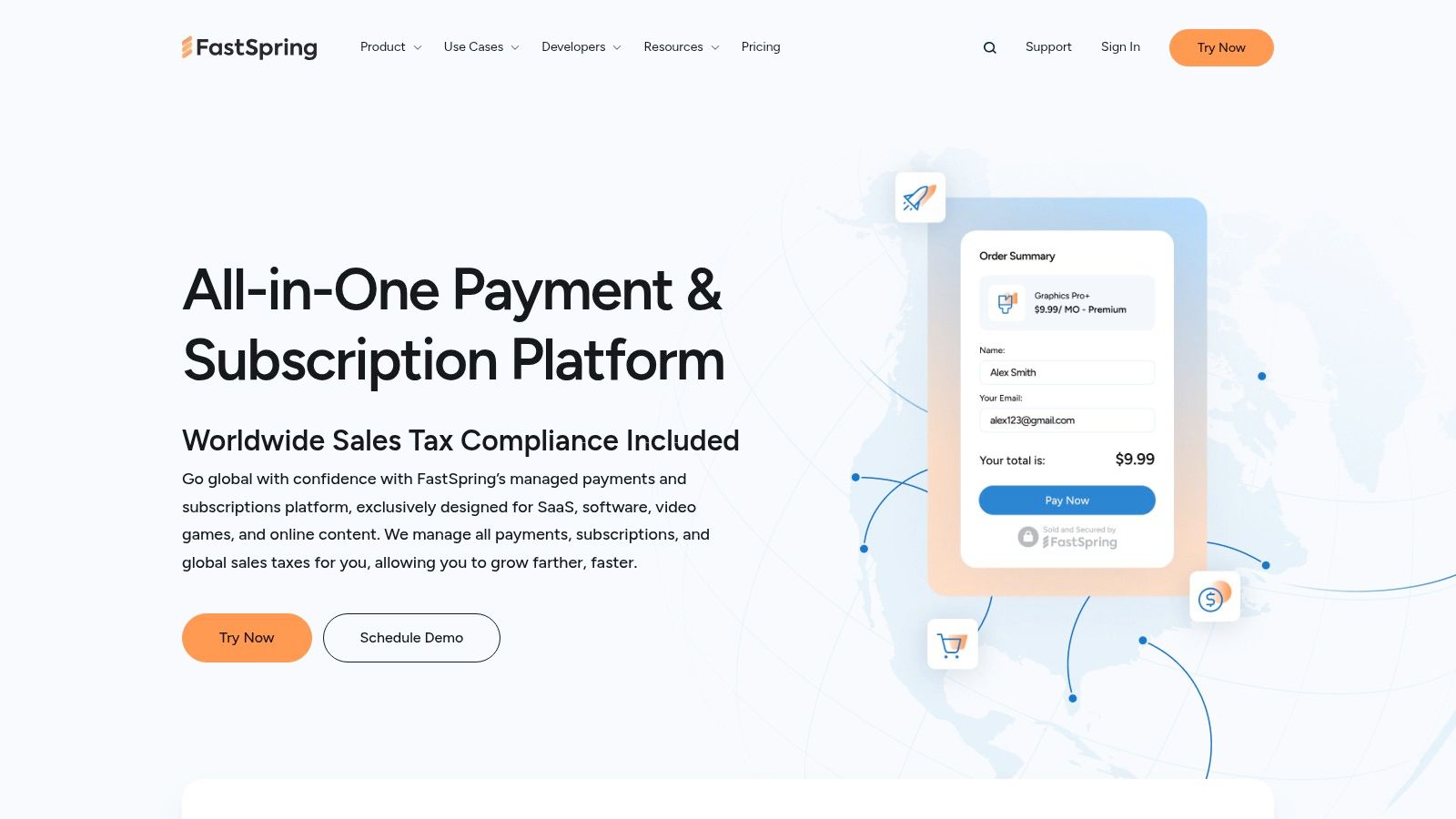
Imagine a software company based in the US wanting to sell its product in Europe. Dealing with VAT, different payment methods, and varying legal requirements across multiple countries can be a logistical nightmare. FastSpring eliminates these hurdles by acting as the merchant of record, meaning they handle all these complexities on behalf of the business. This is a game-changer for smaller businesses and startups that may not have the resources to manage international sales independently. FastSpring's localized checkout experience, supporting 25+ languages and 100+ currencies, further enhances the customer experience and boosts conversion rates.
Features like flexible subscription management with various billing models (e.g., fixed, usage-based, tiered) cater to diverse business needs. The built-in affiliate management system allows for easy expansion of marketing efforts, while fraud protection and chargeback management provide an added layer of security. For software companies, the specialized features for software and digital product licensing and delivery further solidify FastSpring's position as a valuable tool.
Pricing: FastSpring's pricing is usage-based, typically involving a revenue share model. While specific details aren't publicly available, it's generally higher than using a standalone payment processor. Contact FastSpring directly for a tailored quote.
Technical Requirements: FastSpring integrates with various platforms and tools through APIs and webhooks, allowing seamless integration into existing workflows. Technical knowledge is helpful for setup and customization, especially for complex integrations.
Comparison: While platforms like Paddle and Chargebee offer similar merchant-of-record services, FastSpring focuses particularly on software and digital goods, providing specialized features for these industries. Compared to standalone payment gateways like Stripe or PayPal, FastSpring offers a more comprehensive solution, albeit at a higher cost.
Implementation Tips:
- Plan your subscription models: Carefully consider your pricing and billing models before implementing FastSpring. Utilize their flexible options to optimize for your specific product and target market.
- Leverage the localization features: Maximize conversion rates by translating your checkout experience and offering multiple currencies.
- Integrate with existing tools: Utilize FastSpring’s API and webhook capabilities to connect with your CRM, marketing automation platform, and other essential business tools.
Pros:
- Simplifies global selling by handling tax compliance and regulations.
- All-in-one platform for payments, subscriptions, and e-commerce.
- Reduces legal and tax burdens associated with international sales.
- Specialized features tailored for software and digital product businesses.
Cons:
- Higher fees compared to using payment processors alone.
- Less customizable than some dedicated subscription management platforms.
- May offer more features than necessary for businesses focused solely on domestic markets.
Website: https://fastspring.com/
FastSpring earns its spot on this list by offering a robust, all-inclusive solution for businesses selling software and digital products globally. While the higher cost might be a deterrent for some, the value provided in terms of simplified international sales, tax compliance, and comprehensive features makes it a compelling option for businesses looking to scale globally.
8. Chargify
Chargify (now part of Maxio) is a robust subscription management platform specifically designed for B2B SaaS businesses dealing with complex billing requirements. If your business grapples with usage-based billing, tiered pricing, hybrid models, or frequently evolving pricing strategies, Chargify might be the solution you're looking for. Its strength lies in providing the flexibility and customization necessary to handle even the most intricate subscription scenarios. This makes it particularly well-suited for businesses with complex product offerings or those anticipating significant growth and changes in their pricing structure.
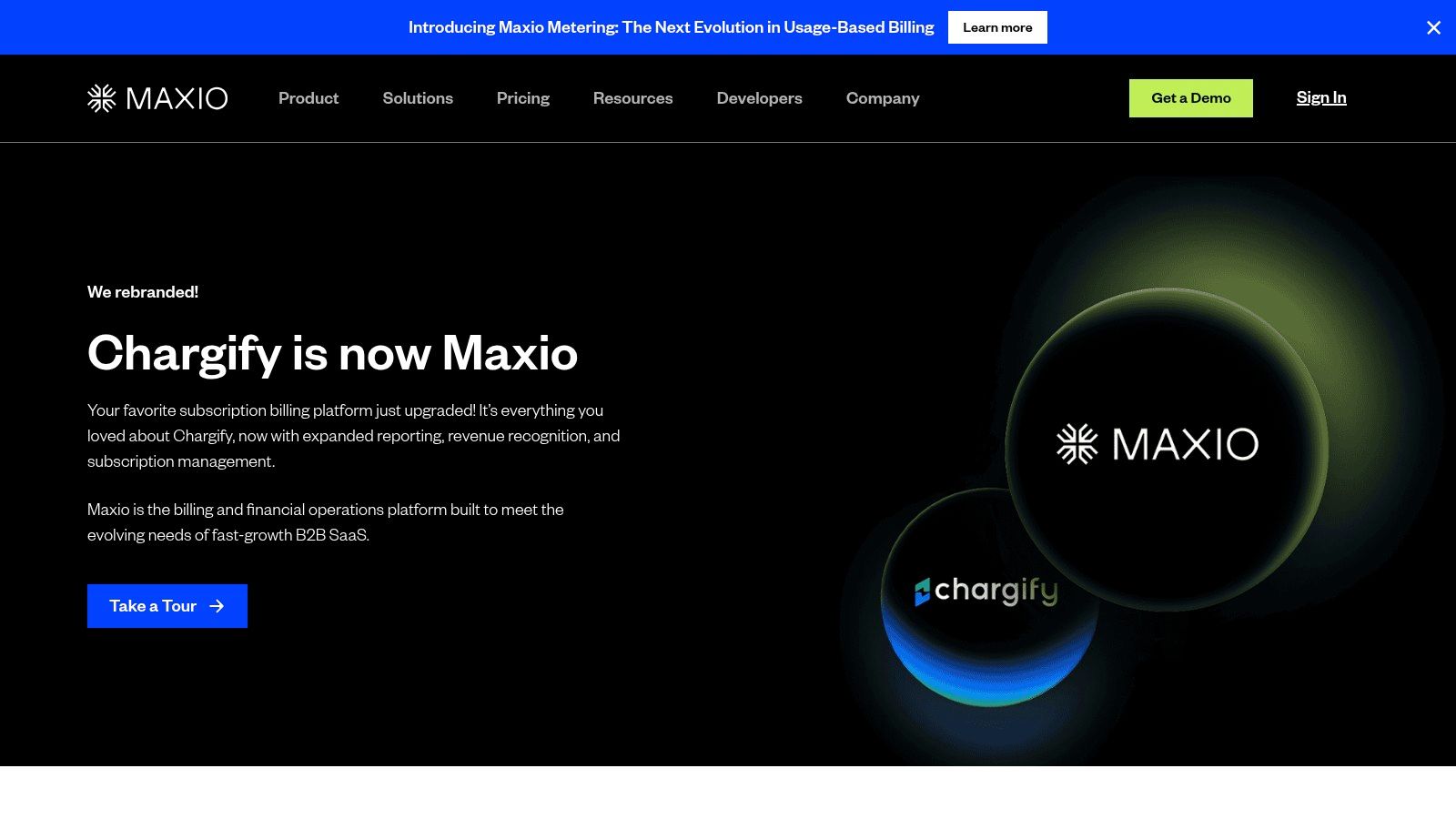
For example, imagine a SaaS business offering a project management tool with various features unlocked based on usage, like the number of projects or users. Chargify can effortlessly handle this by automatically calculating and billing customers based on their specific consumption. Similarly, if you offer tiered pricing plans with different features and limits, Chargify can manage the upgrades, downgrades, and proration calculations seamlessly. It also excels in supporting quote-to-cash processes and Configure-Price-Quote (CPQ) functionality, which are crucial for B2B sales teams.
Chargify's comprehensive feature set includes:
- Advanced B2B billing: Quote-to-cash automation, CPQ functionality, and support for various billing cycles and payment methods.
- Event-based billing and usage metering: Track and bill based on specific events or usage metrics, enabling highly flexible pricing models.
- Customizable portals: Provide branded self-service portals for customers to manage their subscriptions and update their billing information.
- Subscription analytics and BI: Gain deep insights into subscription metrics, churn rates, recurring revenue, and other key performance indicators.
- Revenue recognition and financial reporting: Automate revenue recognition calculations and generate accurate financial reports in compliance with accounting standards.
Pros:
- Exceptional flexibility for complex pricing: Ideal for businesses with usage-based, tiered, or hybrid billing models.
- Strong support for B2B subscription scenarios: Features like quote-to-cash and CPQ streamline B2B sales processes.
- Robust API and developer tools: Enable seamless integration with other business systems.
- Sophisticated revenue recognition capabilities: Ensure accurate financial reporting and compliance.
Cons:
- Complexity: The platform's extensive features can make the initial setup more complex than simpler subscription management tools.
- Higher price point: Chargify's advanced capabilities come at a premium, making it more suitable for larger businesses with complex needs.
- Overkill for simple subscriptions: Businesses with straightforward subscription models might find Chargify's functionality excessive.
Pricing: Chargify's pricing isn't publicly available and requires contacting their sales team for a custom quote. This suggests it's geared towards larger businesses with significant revenue.
Technical Requirements: Chargify is a cloud-based platform, so the primary requirement is a stable internet connection. Integration with other systems is facilitated through a robust API.
Implementation Tips:
- Plan your pricing strategy: Before implementing Chargify, carefully define your pricing models and billing logic.
- Utilize the documentation and support resources: Chargify offers comprehensive documentation and support to help you navigate the platform.
- Test thoroughly: Test all billing scenarios thoroughly before going live to ensure accuracy and avoid potential issues.
Website: https://www.maxio.com/products/chargify
Chargify earns its place on this list by providing a powerful and flexible solution for businesses with complex subscription billing needs. While it may not be the best fit for everyone, particularly smaller businesses or those with simple subscriptions, its advanced capabilities make it a valuable tool for B2B SaaS companies seeking granular control over their billing processes and revenue recognition. If you're looking to scale your subscription business and anticipate needing to handle sophisticated pricing models, Chargify is definitely worth considering.
9. Paddle
Paddle stands out from other subscription management tools by acting as a merchant of record (MOR). This means Paddle handles all the complexities of global sales, including tax calculation, remittance, and compliance, allowing you to focus on developing and marketing your product. This is particularly valuable for SaaS companies and digital product sellers aiming for a global reach without the administrative headaches. Imagine launching your software in multiple countries without having to research and comply with each region's tax laws – that's the power of Paddle. It streamlines your revenue delivery pipeline by combining payment processing, subscription management, and tax compliance into a single platform. This all-in-one approach can drastically reduce operational complexity, especially beneficial for smaller businesses or startups looking to scale rapidly.

Paddle offers a comprehensive suite of features, including end-to-end subscription management and billing infrastructure, checkout optimization and localization for international markets, subscription analytics, and revenue recovery tools. You can also experiment with different pricing models to optimize your revenue strategy. For digital nomads and SaaS businesses targeting international customers, Paddle's ability to handle global tax compliance and localization is a game-changer. This removes a significant barrier to entry for selling in new markets and simplifies the often-daunting task of navigating international regulations. For more details on Paddle's structure, you can learn more about Paddle.
While Paddle offers a robust platform with many advantages, there are some potential drawbacks to consider. Since Paddle acts as the merchant of record and handles such a comprehensive range of services, its fees are generally higher than using a standalone payment processor. This is a trade-off for the simplified compliance and reduced administrative burden. Additionally, Paddle is primarily geared towards digital product and SaaS subscriptions. While it can technically handle physical product subscriptions, it might not offer the same level of flexibility as solutions specifically designed for physical goods. Finally, for large enterprises with extremely complex requirements, Paddle’s customization options might be somewhat limited.
Pros:
- Simplifies global compliance and tax management
- All-in-one solution eliminating the need for multiple tools
- Modern, user-friendly interface and dashboard
- Specialized for digital product and SaaS businesses
Cons:
- Higher fees than payment processors alone due to merchant of record services
- Less flexible for physical product subscriptions
- Limited customization for complex enterprise requirements
Website: https://www.paddle.com/
Paddle's place on this list is secured by its unique approach to simplifying global selling for digital businesses. By taking on the responsibility of tax compliance and acting as the merchant of record, Paddle frees up valuable time and resources, allowing you to concentrate on growth and product development. While the higher fees compared to basic payment gateways might be a concern for some, the value proposition of streamlined global sales and reduced administrative overhead makes it a compelling option, particularly for businesses selling digital products and SaaS internationally. For tech-savvy individuals, small businesses, and digital nomads seeking simplified international sales, Paddle offers a powerful and efficient solution.
10. 2Checkout (now Verifone)
2Checkout, now operating under Verifone, offers a robust platform combining global payment processing with integrated subscription management capabilities. This makes it a particularly compelling option for businesses selling digital goods and services internationally, or those looking to expand their reach across borders. While not solely a subscription management tool, its integrated approach simplifies operations by handling both payments and recurring billing within a single system.
Key Features and Benefits:
- Global Payment Processing: 2Checkout's strength lies in its extensive global reach, supporting transactions in over 200 markets and accepting a wide array of currencies and payment methods. This simplifies international expansion, removing the complexities of dealing with multiple payment gateways and local regulations. For digital nomads and businesses with a global customer base, this feature is invaluable.
- Integrated Subscription Management: The platform handles recurring billing, subscription management, and dunning processes, automating revenue collection and reducing administrative overhead. This is beneficial for small businesses and tech-savvy individuals managing multiple online services.
- Tax Compliance: 2Checkout acts as a Merchant of Record (MoR) in many jurisdictions, simplifying global tax compliance by handling calculations and remittances. This is a significant advantage for businesses selling internationally, as it minimizes the burden of navigating complex tax laws in different countries.
- Risk Management and Fraud Prevention: Built-in tools help protect businesses from fraudulent transactions and chargebacks, ensuring secure payment processing.
- Digital Commerce Optimization: Features like cart abandonment recovery help maximize sales and revenue.
Use Cases:
- Software-as-a-Service (SaaS) businesses: 2Checkout's global reach and integrated payment processing make it suitable for SaaS companies targeting international markets.
- E-commerce businesses selling digital goods: The platform is well-suited for selling digital products like online courses, ebooks, and software downloads globally.
- Subscription box services: While perhaps not as feature-rich as dedicated subscription management platforms for physical goods, the global payment processing capabilities are a significant advantage for businesses shipping internationally.
Pros:
- Strong international payment support: This is a key differentiator for businesses with a global customer base.
- Combined payment processing and subscription management: Streamlines operations by managing both functions within a single platform.
- Simplified global tax compliance: The MoR service significantly reduces the administrative burden of international sales.
- Extensive payment method support: Caters to diverse customer preferences, increasing conversion rates.
Cons:
- Less specialized subscription features: Compared to dedicated subscription management platforms, 2Checkout may lack some advanced features like complex subscription tiers or promotional options.
- User interface not as modern as some competitors: While functional, the interface may not be as intuitive or visually appealing as some newer platforms.
- Higher transaction fees compared to payment-only processors: The integrated approach comes at a price, with transaction fees potentially higher than using separate payment gateways.
- Limited customization for complex subscription scenarios: Businesses with highly complex subscription models may find the platform's flexibility limited.
Pricing and Technical Requirements:
Pricing information for Verifone's services is typically available upon request and is tailored to specific business needs and transaction volume. Technical requirements are generally minimal, involving integrating the platform with your website or e-commerce platform.
Implementation Tips:
- Clearly define your international expansion strategy: Before implementing 2Checkout, clearly identify your target markets and required payment methods.
- Utilize the MoR service strategically: Take advantage of the MoR service to simplify tax compliance in your target markets.
- Test the integration thoroughly: Ensure seamless integration with your existing systems before going live.
Why 2Checkout Deserves Its Place on the List:
While not solely focused on subscription management, 2Checkout’s combined approach to global payment processing and recurring billing offers a compelling solution for businesses expanding internationally or selling digital goods across borders. Its simplified tax compliance features and broad payment method support are particularly valuable for navigating the complexities of global e-commerce. While it might not be the perfect choice for businesses with highly complex subscription models, its integrated approach makes it a strong contender for those seeking a streamlined solution for international sales.
Website: https://www.verifone.com/en/digital-ecommerce
Top 10 Subscription Management Tools: Quick Feature Comparison
| Platform | Core Features ★ | Audience 👥 | Unique Selling Points ✨ | Value Proposition 💰 |
|---|---|---|---|---|
| 🏆 AccountShare | Group purchasing, fast response, secure sharing | Tech-savvy users, families, SMBs, students | Guaranteed availability, priority new features | Reduced cost, premium access |
| Chargebee | Automated billing, multi-currency support, APIs | SaaS and subscription-based businesses | Custom integrations, end-to-end lifecycle management | Scalable and robust solution |
| Zuora | Order-to-revenue automation, multi-currency | Large enterprises, global operations | CPQ integration, strong compliance, enterprise-grade | Comprehensive and scalable |
| Recurly | Revenue recovery, smart retry logic, analytics | Digital products, SaaS, e-commerce companies | Advanced dunning, churn prevention | Optimizes subscription revenue |
| ReCharge | E-commerce subscriptions, inventory tools | E-commerce merchants | Shipping logistics, flexible product swapping | Streamlined physical subscription management |
| Stripe Billing | API-driven billing, invoicing, smart retry | Tech companies with in-house development | Seamless integration with Stripe ecosystem | Competitive pricing with global support |
| FastSpring | Merchant of record, tax compliance, localized checkout | Software, SaaS, and digital product sellers | All-in-one solution, built-in fraud protection | Simplifies global selling |
| Chargify | B2B billing, quote-to-cash, CPQ capabilities | B2B SaaS with complex pricing models | Exceptional flexibility, robust API | Sophisticated revenue management |
| Paddle | End-to-end billing, tax compliance, subscription tools | SaaS and digital businesses globally | All-in-one revenue delivery platform | Simplifies global compliance and sales |
| 2Checkout (Verifone) | Global payment processing, recurring billing | International digital sellers | Integrated risk management, tax handling | Unified processing and subscription solution |
Choosing the Right Tool for You
From robust platforms like Zuora and Chargebee designed for enterprise-level subscription management, to more agile solutions like Recurly and Paddle catering to SaaS businesses, and even streamlined options like ReCharge for ecommerce subscriptions, the tools covered in this article offer a wide spectrum of capabilities. We've also explored specialized tools like FastSpring for digital goods and 2Checkout (now Verifone) for global payments, highlighting the diverse landscape of subscription management. Remember, the most important takeaways are to consider your specific needs, budget, and desired level of automation when making your decision. Think about your current billing model, future scalability needs, and necessary integrations with existing systems.
Gathering feedback is crucial for understanding your customer's needs and preferences, particularly regarding their subscriptions. To streamline this process and gain valuable insights, consider using dedicated customer feedback collection tools from Testimonial. This will enable you to tailor your offerings and improve customer satisfaction. By carefully weighing these factors and exploring the options presented, you can streamline your subscription operations, optimize recurring revenue streams, and ultimately enhance your customer experience.
Managing multiple subscriptions effectively can be a significant challenge, especially as you adopt more services to boost productivity or entertainment. For a smart and secure way to share and manage your subscriptions with family or within a small team, explore AccountShare. AccountShare offers a streamlined approach to collaborative subscription management, making it easier than ever to share the benefits of premium services while maintaining control and transparency.
